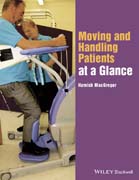
A clear, concise and comprehensive guide to moving and handling patients Superbly illustrated, with full colour photographs throughout Practice–oriented and based on the latest evidence to provide safe and effective patient care Ideal for nursing students, health care assistants, newly qualified nurses, as well as physiotherapists and occupational therapists INDICE: Preface .Part 1: Theory .1. Legislation I .2. Legislation II .3. Structure and function of the spine .4. Posture and back care .5. Safe principles of moving and handling .6. Controversial techniques .7. Risk assessment: moving and handling .8. Risk assessment: general .9. Individual patient handling assessment .Part 2: Practice Load handling and practical application of ergonomics .10. Lifting a load .11. Pushing a bed .12. Good workstation set–up .13. Postural issues with laptops and tablets Moving a patient In and out of a chair and walking .14. Assessing the patient .15. Moving a patient forward in a chair .16. Standing a patient: with one handler .17. Standing a patient: with two handlers .18. Seating a patient .19. Moving a patient back in a chair .20. Walking with handler(s) .21. Tips for using walking frames .22. Assisting a patient off the floor: verbal Sitting a patient up, and in and out of bed .23. Sitting a patient using an electric profiling bed .24. Sitting a patient using a non–profiling bed .25. Sitting a patient onto the side of an electric profiling bed .26. Sitting a patient onto the side of a non–profiling bed .27. Lying a patient from the bed edge .28. Standing a patient from the bed edge .29. Standing a patient from the bed edge using a profiling bed Moving a patient within the bed .30. Turning a patient in bed: verbal .31. Turning a patient in bed: one handler .32. Turning a patient in bed: two handlers .33. Inserting a roller slide sheet under a patient .34. Inserting two flat slide sheets under a patient: unravelling technique .35. Inserting two flat slide sheets under a patient: by rolling patient .36. Moving a semi–independent patient up the bed on a roller slide sheet .37. Moving a patient up the bed with a roller slide sheet .38. Moving a patient up the bed with two flat slide sheets .39. Turning a patient in bed with roller slide sheets .40. Turning a patient in bed with flat slide sheets .41. Moving a patient s legs into bed with a slide sheet Use of hoists and slings .42. Types of hoist .43. Types of sling .44. Insertion of sling into bed .45. Removal of sling from bed .46. Insertion of sling into chair .47. Removal of sling from chair .48. Insertion of sling into bed with slide sheets .49. Insertion of sling into chair with slide sheets .50. Hoisting from bed to chair with a mobile hoist .51. Hoisting from chair to bed with a mobile hoist .52. Hoisting from the floor with a mobile hoist .53. Using a standing hoist Lateral transfers .54. Lateral transfer from bed to bed/trolley .55. Transfer from chair to bed using a transfer board Other handling equipment .56. Assisting a patient to use a rota stand: one handler .57. Assisting a patient to use a rota–stand: two handlers .58. Use of standing and raising aids (non–mechanical) .59. Use of equipment for bariatric patients .60 Kneeling and working at floor level .Case studies .Case study 1: Assessing a bariatric patient .Case study 2: Managing leg ulcer dressings in the community (kneeling) .Index
- ISBN: 978-1-118-85343-6
- Editorial: Wiley–Blackwell
- Encuadernacion: Rústica
- Páginas: 144
- Fecha Publicación: 22/01/2016
- Nº Volúmenes: 1
- Idioma: Inglés
